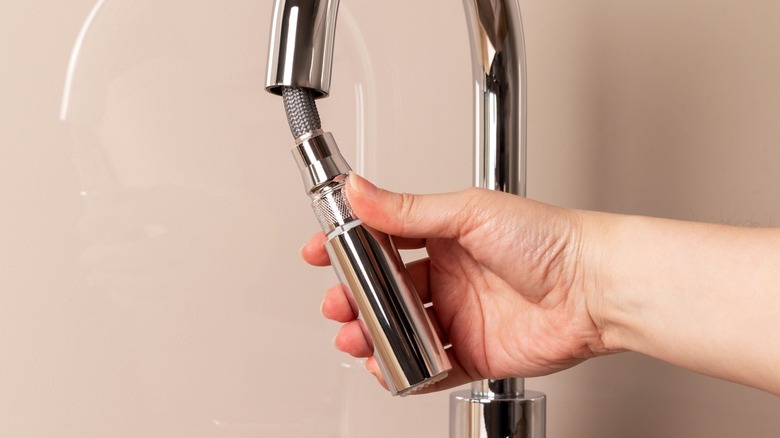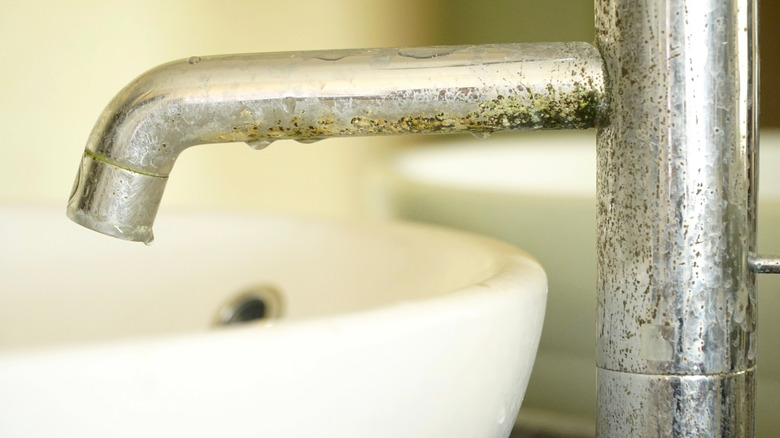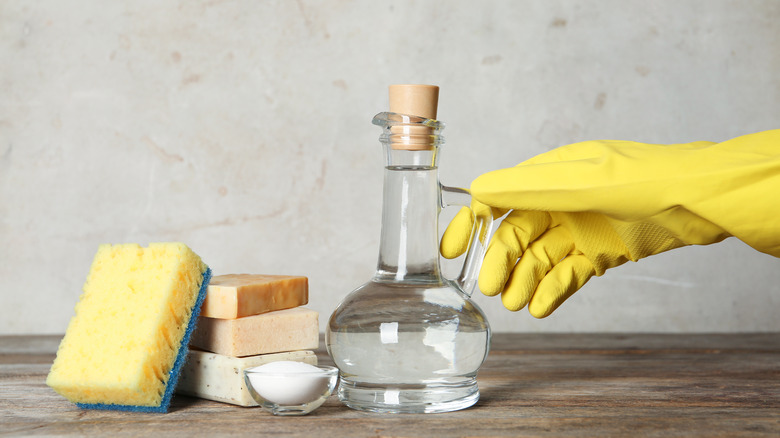The Easiest Way To Clean Residue From Your Kitchen Faucet Head
Sinks take the brunt of our kitchen messes, weathering crusty pans, hot plates, and the splash of discarded cooking liquids. Cleaning dishes and ingredients can ultimately leave the area dirty even after the rest of the kitchen is clean. These food particles and leftovers can feed bacteria and the lingering moisture can foster mold.
That's why it's important to take the time to clean every part of your sink, faucet included, and wipe it dry. Before you break out the heavy-duty abrasives, which could damage metal fixtures, turn to three kitchen staples that are likely already on hand: a plastic bag, white vinegar, and a rubber band. You'll use these three items, along with water, to soak and scrub the metal back to its former glory.
Fill a plastic bag with half a cup of water and half a cup of white vinegar, scaling the combination up or down as needed but maintaining a one-to-one ratio. Submerge the faucet head in the bag and secure it with the band to allow the whole thing to soak for about 30 minutes. This hands-off tactic should encourage residue to slip free with ease.
The build-up on your faucets and sinks
Once the process is complete, you may find the baggie contains dark specks or even slime, just as you would when cleaning a Brita pitcher. This is likely mildew that's grown on the wet surface. The acidic vinegar will remove the mold and may even freshen up the smell of the space — a benefit you may have experienced after cleaning the inside of your dishwasher.
Another common culprit lingering on your faucets is a black goo that's actually a build-up of minerals. Oxidized manganese and iron, two common metals, in small quantities, are perfectly safe, but they could contribute to staining if you have a white sink. They also encourage the growth of dark sludge on your faucet head. Thankfully, they're easy to remove and nothing to fear when you catch a few spots floating in your baggie.
Households dealing with hard water, which causes those white and yellow stains and crust, will find the diluted vinegar soak aids in descaling, too. This will return the shine to stainless appliances, similar to vinegar's ability to remove the rainbow sheen and hard water stains from pans. As with your pots and pans, you can use a baking soda-water paste mixture to tackle any remaining stains after you finish soaking.
Using your cleaning power wisely
Before digging into the process, keep in mind that this approach works best on stainless steel, as the acid could damage delicate finishes and varnishes. Make sure the vinegar is properly diluted, as well, to avoid discoloring or stripping the metal. In other words, if your sink is bronze, gold, black, or chrome, you may want to hold off on this trick and stick to milder soap and water rubs.
This is all the more reason to take the process slowly, starting with a 30-minute soak and then scrubbing or soaking longer as needed and even overnight. It works best after you've been running the sink — think right after working through a mountain of dishes — as the debris may be slightly loosened. Follow up the vinegar bath with a gentle scour using a toothbrush or soft sponge to knock off any remaining bits.
Once you get the hang of the deep clean, extend the benefits by wiping the faucet head clear with a paper towel after you finish wiping down the sink each night. Enthusiastic cleaners can also practice the soaking approach with shower heads and bathroom faucets. Just make sure to be careful when securing the acidic liquid overhead, as you don't want to get it in your eyes.



